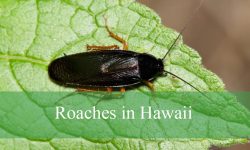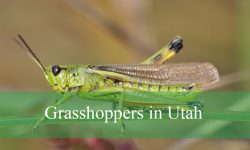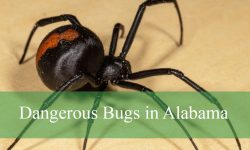Montana’s wide landscapes, stretching across prairies, valleys, and wooded mountains, support an impressive variety of ant species. Most ants play positive roles in nature, but a few can bite or sting, causing painful reactions for people and animals. Knowing which ants are aggressive and how to identify them helps protect your home and outdoor areas throughout the warmer months.
Ants in Montana contribute to the balance of local ecosystems by aerating soil, recycling organic matter, and controlling pest populations. However, some species such as Harvester Ants, Thatching Ants, and Carpenter Ants are known for their painful bites or stings and can become unwanted visitors around homes and gardens. Learning to recognize their nests and behaviors allows for safer and more effective control.
This complete guide explores the most common biting ants in Montana, describing their size, coloration, nesting habits, and level of aggression. It also offers clear advice for preventing infestations and treating bites while appreciating the ecological importance of these small but powerful insects.
Types of Biting Ants Found in Montana
Field Ant (Formica spp.)
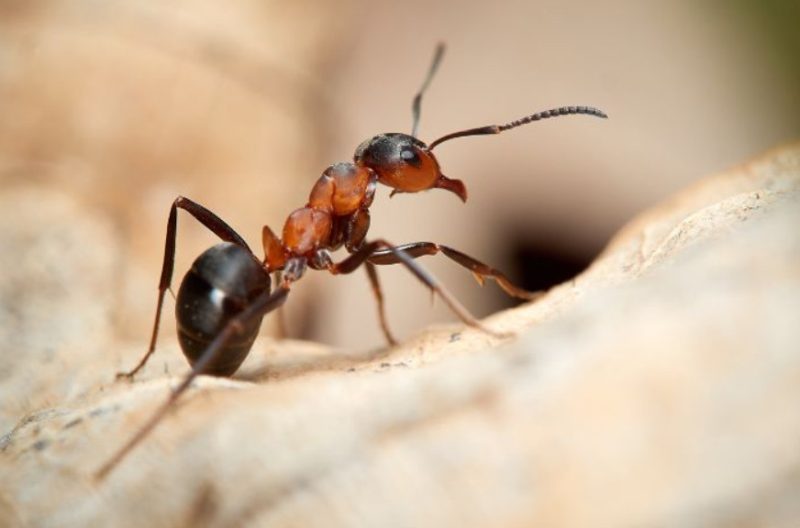
Field ants are among the most common biting ants in Montana, often seen in grassy areas, meadows, and open forests. They vary widely in color, ranging from reddish-brown to black, and can grow between 4 to 8 millimeters in length. Their bodies are slender and shiny, with a distinct segmented waist and long legs adapted for quick movement. Colonies of field ants are large and typically build mounds made of soil, plant debris, or small stones.
These ants are easily identified by their large mounds that can reach several inches high, especially in sunny, open locations. Workers can often be seen actively foraging during the warmer hours of the day, collecting dead insects, nectar, and honeydew from aphids. They do not have a stinger but can deliver a sharp bite and spray formic acid into the wound, causing a brief burning sensation.
Field ants are aggressive defenders of their colonies. When disturbed, hundreds of workers may swarm out to attack intruders, biting repeatedly while applying acid to the skin. Though their bites are not medically significant, they can be painful, particularly if multiple ants attack at once. People allergic to insect bites may experience mild swelling or irritation.
These ants play an important ecological role in Montana’s ecosystems by aerating the soil and controlling other insect populations. They are typically found in pastures, grasslands, and near forest edges. During summer, their nests become particularly active, and their foraging trails can stretch several meters from the mound, making them one of the most visible ant species in the region.
Thatching Ant (Formica obscuripes)
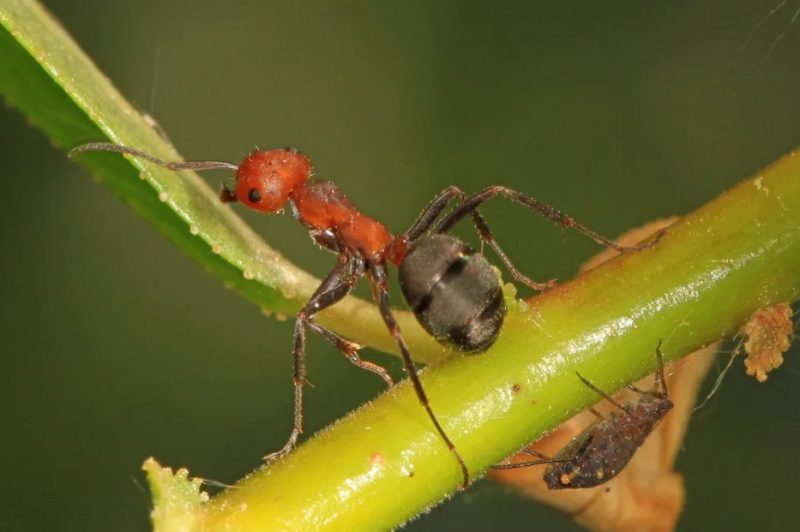
The Thatching Ant, a large and powerful species in Montana, is recognized by its distinctive habit of building dome-shaped mounds covered with grass, pine needles, and small twigs. These mounds can reach up to 3 feet in diameter and are often located in open fields or along forest edges. The ants themselves are reddish-brown with darker abdomens, measuring about 5 to 9 millimeters long, and move quickly when disturbed.
Identification of Thatching Ants is straightforward due to their thatched nest structures and noticeable trails leading to feeding areas. Colonies can contain tens of thousands of workers and multiple queens. They are highly territorial, often waging battles with neighboring colonies to defend their territory. Workers forage for insects, honeydew, and plant material, making them both predators and scavengers in the local ecosystem.
While they lack a stinger, Thatching Ants deliver painful bites and can spray formic acid into the wound. The acid has a pungent odor and causes a stinging or burning sensation on human skin. Although not dangerous, the irritation can persist for several minutes and may cause minor swelling. People working near thatching ant mounds are advised to wear gloves and boots to avoid bites.
These ants are crucial to the environment because their nesting behavior helps mix and enrich soil nutrients. In Montana, they are widespread in prairies, open pine forests, and mountainous meadows. Their mounds are easy to spot in sunny areas, often serving as natural heating chambers that regulate the colony’s internal temperature.
Western Thatching Ant (Formica integroides)
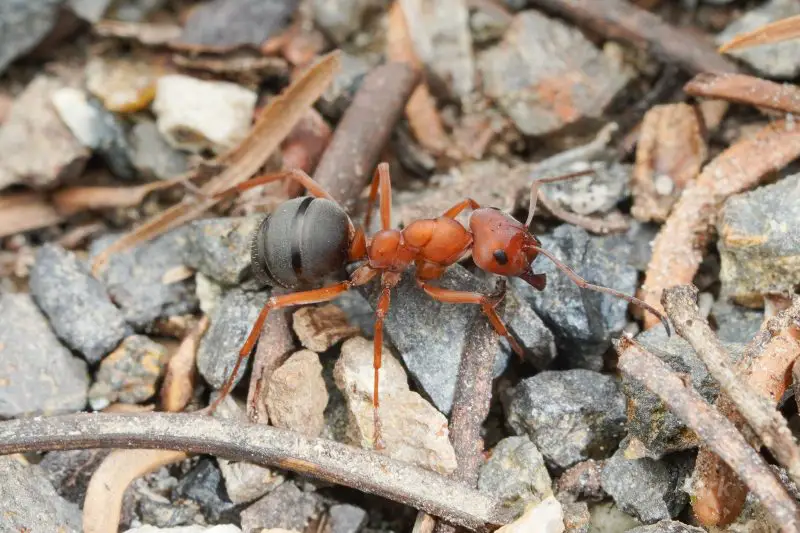
The Western Thatching Ant closely resembles its cousin, Formica obscuripes, but has subtle differences in coloration and nesting habits. This species is slightly smaller, averaging 4 to 8 millimeters long, and has a reddish thorax with a black head and abdomen. Their mounds are typically built with finer materials such as small twigs, grasses, and pine needles, and are usually found in open forests or near mountain slopes.
They are known for their complex social structure, which includes cooperative relationships between multiple colonies. These ants communicate through chemical signals and can coordinate foraging over large distances. Their trails are highly organized, with workers frequently seen carrying food, such as dead insects and aphid honeydew, back to the nest.
Like other thatching ants, Western Thatching Ants do not sting but rely on their strong mandibles to bite. Their bites can be quite painful, especially when they release formic acid as a defense mechanism. The acid causes a burning sensation on human skin and can leave a lingering smell. Multiple bites may lead to redness or mild blistering, although severe reactions are uncommon.
In Montana, Western Thatching Ants thrive in dry, sunny environments and are especially common in pine woodlands and foothill grasslands. Their nests are vital to soil turnover and insect population control, contributing to a balanced ecosystem. These ants are particularly active during the warmer months and can often be seen maintaining their thatched mounds under the bright summer sun.
Carpenter Ant (Camponotus modoc)
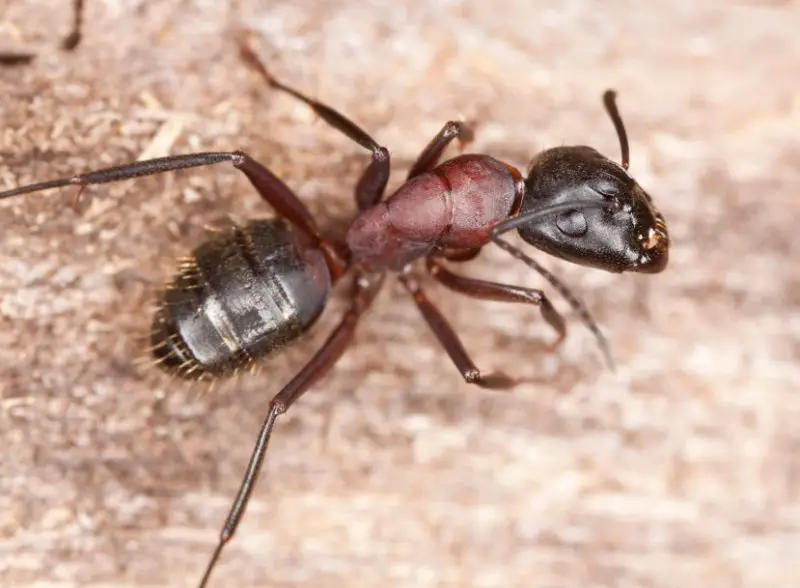
The Carpenter Ant (Camponotus modoc) is one of the largest ant species in Montana, with workers reaching up to 13 millimeters in length. They are black or dark brown with slight reddish hues on the thorax. Unlike most other ants, they do not build soil mounds but excavate wood to create elaborate tunnel systems. Their preference for damp or decaying wood makes them common in forested regions and occasionally in homes with moisture problems.
These ants can be identified by their smooth, rounded thorax and large size compared to other native species. They move slowly and deliberately and are most active during nighttime. Carpenter Ants are not typically aggressive but will bite when threatened. Their strong mandibles can pierce human skin, causing a brief pinch. Unlike some species, they do not sting or use venom.
Carpenter Ants are not poisonous, but their nesting behavior can cause significant structural damage to wooden buildings and trees. They do not eat wood; instead, they chew through it to create tunnels and chambers for their colonies. They feed primarily on insects, plant juices, and household sweets, often becoming pests in kitchens and pantries.
In Montana, Camponotus modoc thrives in coniferous forests, especially in areas with moist, decaying logs. Colonies are long-lived, sometimes surviving over a decade. While they play an ecological role in decomposing wood, homeowners should watch for signs of infestation, such as sawdust piles and faint rustling sounds within walls during the night.
Black Carpenter Ant (Camponotus pennsylvanicus)
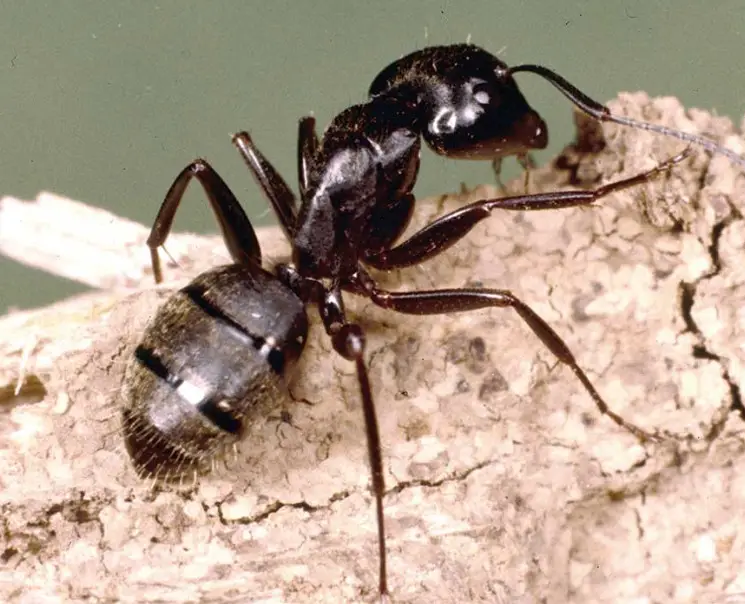
The Black Carpenter Ant is another large and common biting species in Montana. These ants are entirely black, shiny, and robust, with workers ranging from 6 to 12 millimeters in length. They are often confused with other dark-colored ants but can be distinguished by their evenly rounded thorax and large size. Like their western relatives, they nest in wood but prefer decayed or moisture-softened logs, stumps, or even house structures.
Their colonies can grow to include thousands of workers and several queens. Black Carpenter Ants are mostly nocturnal, emerging after dusk to forage for food such as dead insects, honeydew, and sugary substances. They are not aggressive by nature but will bite when disturbed. Their bite, though not venomous, can be painful due to their powerful jaws. Some individuals may experience mild irritation at the bite site.
Unlike ants that sting, Carpenter Ants rely solely on their mandibles for defense. They do not produce venom, but their bites can be strong enough to break the skin. Despite their intimidating size, they play an important role in forest decomposition by helping break down dead wood. However, inside homes, they can become a nuisance when they tunnel into wooden structures, weakening beams and walls.
In Montana, Black Carpenter Ants are widely distributed in wooded areas, especially around lakes, cabins, and campgrounds. They thrive in moist climates where decaying wood is plentiful. During spring and summer, winged reproductives swarm to establish new colonies, which can persist for many years. Their presence around homes is often a sign of water damage or decaying timber nearby.
Allegheny Mound Ant (Formica exsectoides)
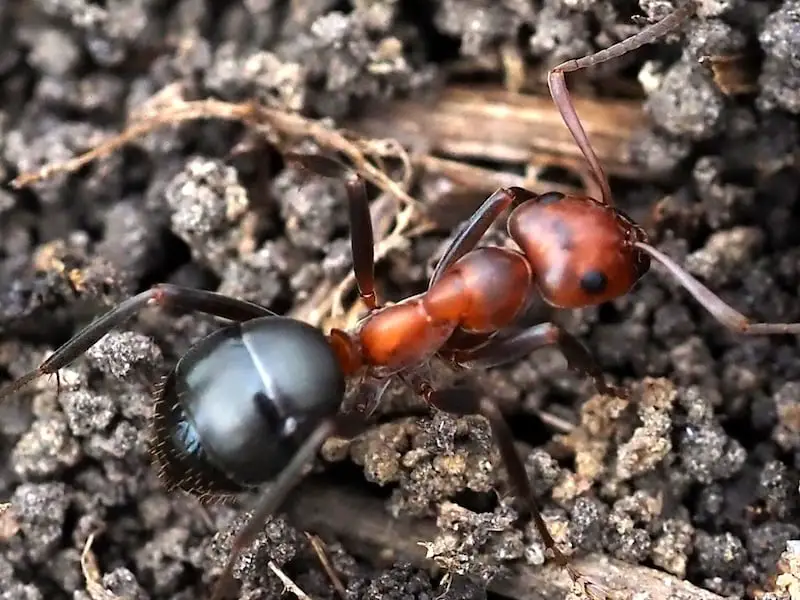
The Allegheny Mound Ant is one of Montana’s most recognizable and aggressive biting ants. It builds impressive mounds made of soil, grass, and debris, which can stand more than 3 feet tall and stretch several feet across. These reddish-brown ants measure about 4 to 8 millimeters long and feature a darker brown abdomen with fine hair. Colonies are large and can contain hundreds of thousands of workers. Their mounds are often found in sunny, grassy fields and forest edges.
Identification of this species is straightforward due to its massive soil mounds and high activity level. Workers are highly territorial and will swarm out in large numbers when disturbed. They are known to inject formic acid into plants and small shrubs surrounding their nests, killing vegetation to maintain open sunlight over the colony. This unique behavior distinguishes them from other Montana ant species.
While Allegheny Mound Ants do not sting, they bite aggressively. Their bites are painful, and they spray formic acid into the wound, which causes a sharp burning sensation. The pain can last several minutes, and sensitive individuals may experience redness or swelling. They are particularly defensive during hot summer days when colonies are at peak activity.
These ants prefer well-drained soils and open habitats. In Montana, they are found in meadows, forest clearings, and near hiking trails. Their mounds are often visible from a distance due to their size. Ecologically, they aerate the soil and control insect populations, but their vegetation-killing habits can make them a nuisance for landowners and gardeners.
Pavement Ant (Tetramorium immigrans)
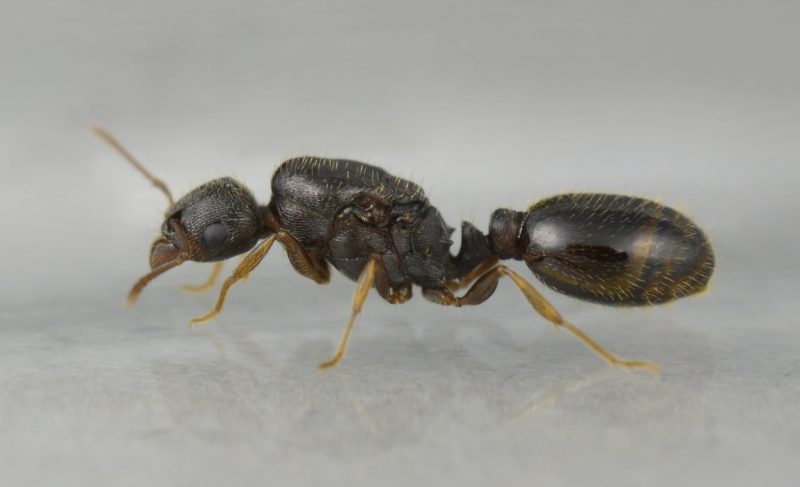
The Pavement Ant is a small but persistent ant species commonly found in Montana’s urban and suburban areas. Measuring 2.5 to 4 millimeters long, these ants are dark brown to black with fine parallel grooves on their head and thorax. They get their name from their habit of nesting beneath sidewalks, driveways, and building foundations. Pavement Ants are highly adaptable and thrive in disturbed environments, making them one of the most common ants found in homes and yards.
Their nests are often identified by small piles of displaced soil pushed up through cracks in pavement or along concrete edges. Workers are slow-moving and can be seen foraging in long, orderly trails. They feed on a wide variety of food, including grease, sweets, dead insects, and pet food. Colonies typically have multiple queens, allowing for rapid expansion in suitable areas.
Pavement Ants are not particularly aggressive, but they will bite if handled or disturbed. Their bite is mild and generally not painful, as they lack a stinger and do not inject venom. However, they can become a nuisance when foraging indoors, especially during the warmer months. They sometimes engage in large “ant wars” between colonies, where thousands of workers fight for territory, often visible on sidewalks or driveways.
In Montana, Pavement Ants are most common in populated regions such as Billings, Missoula, and Great Falls. They survive the cold winters by nesting deep below the frost line and emerge in spring to resume foraging. Though not dangerous, they are considered household pests due to their persistence and large colony sizes.
Cornfield Ant (Lasius alienus)
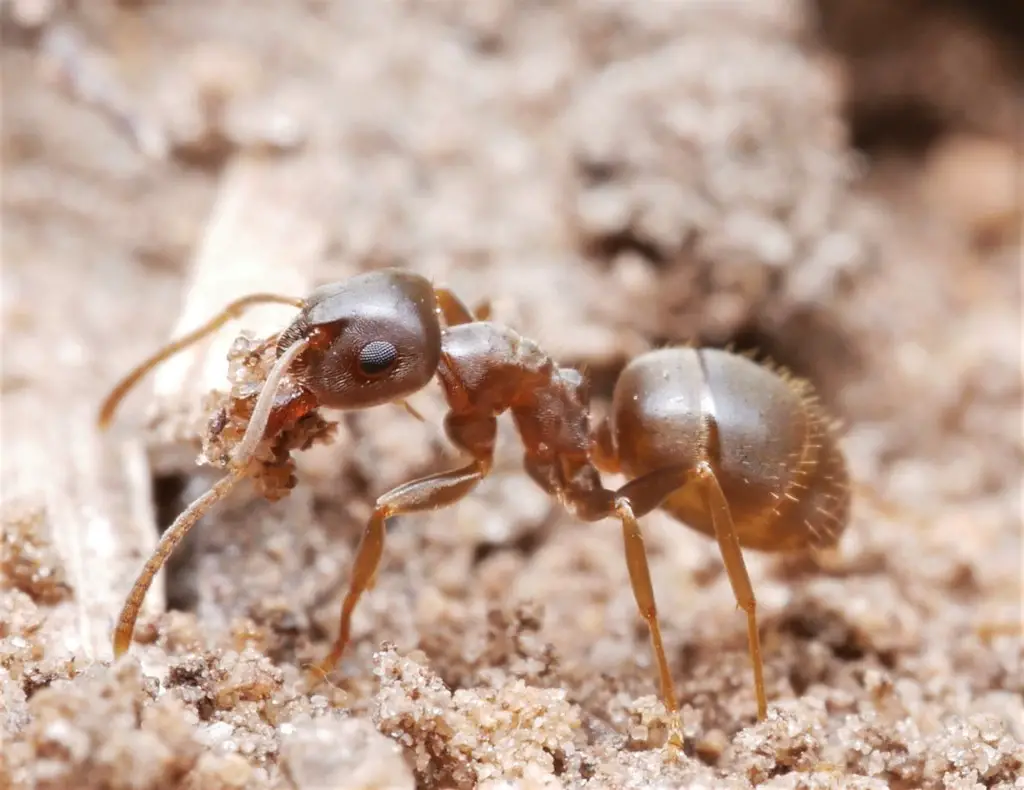
The Cornfield Ant is a small, light brown to yellowish species commonly found across Montana’s agricultural and grassy landscapes. Workers measure about 2.5 to 4 millimeters long and have a shiny, smooth appearance with slightly darker heads. Their nests are built underground, often in open fields, pastures, and lawns, forming small soil craters around the entrance. These ants are among the most widespread species in temperate climates.
Cornfield Ants are most active during the day and feed primarily on honeydew from aphids and mealybugs. They protect these insects in exchange for the sugary substance they produce, creating a mutually beneficial relationship. Workers can sometimes be found tending aphid colonies on crops or garden plants, which can indirectly contribute to pest problems.
Though they can bite, Cornfield Ants are generally non-aggressive and rarely cause harm. Their bites are weak and cause little discomfort to humans. They do not sting or produce venom, making them harmless compared to other biting species. However, they may become pests when nesting in lawns, as their mounds can disfigure turf and create uneven ground.
In Montana, Cornfield Ants thrive in open environments, including agricultural fields and grasslands. They are especially common in areas with loose, sandy soil. Colonies can persist for years, expanding gradually as new queens establish nearby nests. Their ecological role includes soil aeration and assisting in seed dispersal, making them beneficial to local ecosystems despite their occasional nuisance status.
Yellow Meadow Ant (Lasius flavus)
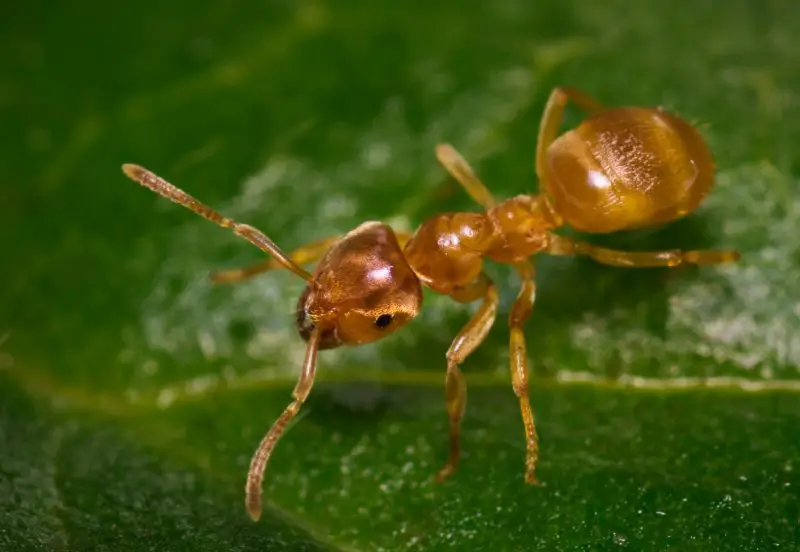
The Yellow Meadow Ant is a subterranean species found throughout Montana’s prairies and meadows. These ants are easily identified by their yellow to golden-brown coloration and small size, averaging 2 to 4 millimeters long. Unlike most other species, they spend almost their entire lives underground, rarely venturing to the surface except during mating flights in late summer. Their nests often form dome-shaped mounds covered in short grass or moss.
Yellow Meadow Ants are shy and slow-moving, preferring damp soil in open grassy areas. They primarily feed on the honeydew of root aphids, which they protect within their tunnels. Their underground lifestyle makes them less visible but very common. Colonies can last for decades, expanding slowly beneath the surface with minimal disturbance to the surrounding environment.
Though not aggressive, these ants can bite when handled. Their bites are mild and rarely felt, as they have small mandibles and no sting. They are harmless to humans and pets, and their nests do not damage structures or crops. However, in lawns or golf courses, their mounds may become visible as small, soft humps in the turf.
In Montana, Yellow Meadow Ants are most often found in open valleys, grasslands, and gently sloping hills. Their presence helps aerate compacted soil, promoting healthy plant growth. They are important to the ecosystem, serving as prey for birds, lizards, and ground beetles. Their discreet lifestyle makes them one of Montana’s most overlooked yet ecologically valuable ant species.
Odorous House Ant (Tapinoma sessile)
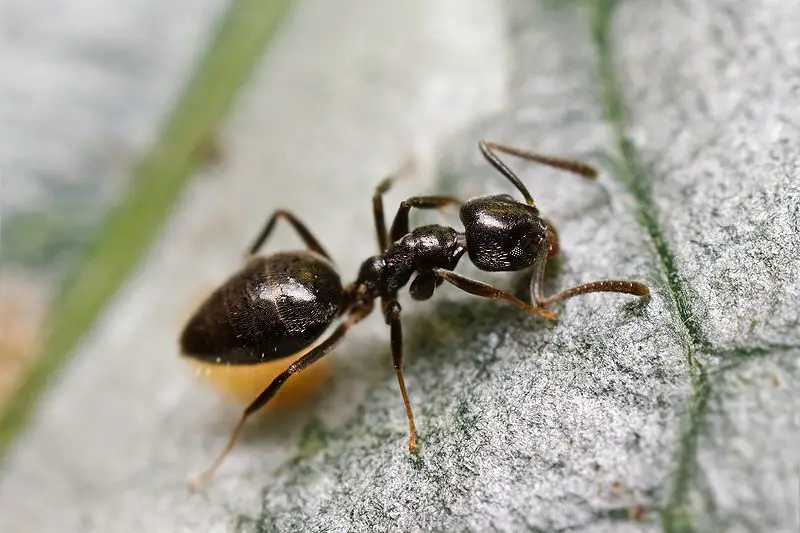
The Odorous House Ant is a small, dark brown to black species known for the distinct coconut-like odor it emits when crushed. Workers are about 2.5 to 3.5 millimeters long, with an uneven thorax and a hidden petiole that gives the body a smooth, continuous appearance. These ants are among the most common indoor pests in Montana, nesting in walls, under floors, or outdoors beneath stones and logs.
Identification of this species is aided by its distinctive smell and tendency to form long, irregular trails. Colonies can contain thousands of workers and multiple queens, allowing them to rebound quickly even after partial extermination. Odorous House Ants are opportunistic foragers, feeding on sweets, fruits, dead insects, and pet food. They are especially attracted to sugary substances like spilled soda or honey.
Though they can bite, their bites are weak and not painful. They do not sting or inject venom, making them harmless to humans. However, their persistent infestations can be frustrating, as they quickly relocate nests when disturbed. They are highly adaptable and can nest both indoors during winter and outdoors in warm weather.
In Montana, Odorous House Ants are widespread in both urban and rural settings. They thrive in moist environments, often near kitchens, bathrooms, and foundations. Their colonies can survive harsh winters by moving indoors for warmth. While they do not pose a medical threat, maintaining cleanliness and sealing entry points is essential to prevent infestations.
Little Black Ant (Monomorium minimum)
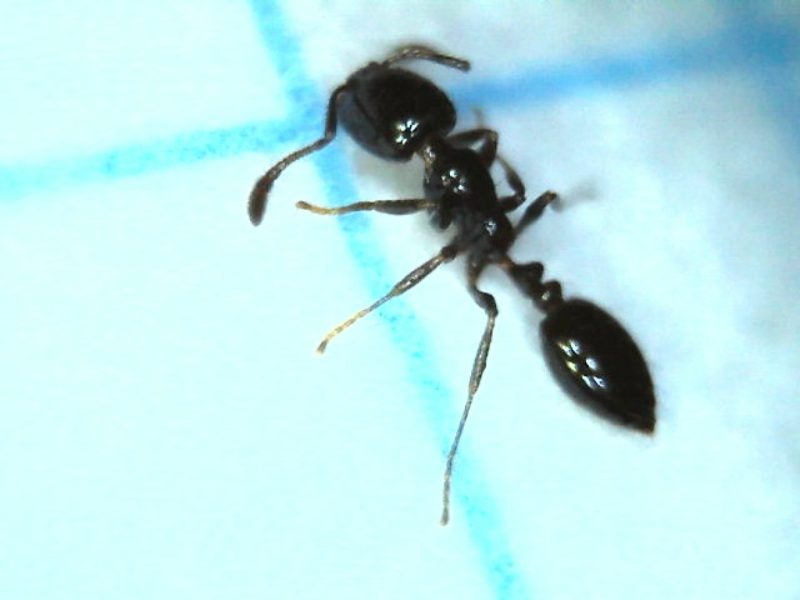
The Little Black Ant is one of Montana’s smallest and most persistent ant species, often found both outdoors and inside homes. Workers are jet black and glossy, measuring only about 1.5 to 2 millimeters long. Their small size allows them to infiltrate cracks, crevices, and other tight spaces, making them frequent indoor pests. Colonies can have multiple queens and thousands of workers, allowing for rapid expansion once established.
These ants are easy to identify due to their uniform black color, small body, and slow, deliberate movements. They prefer to nest under stones, logs, or in decaying wood, but inside homes, they may occupy wall voids or foundations. Little Black Ants forage in organized trails and are often seen traveling along kitchen counters or window sills in search of food. They are omnivorous, feeding on sweets, oils, and dead insects.
Little Black Ants do bite, though their small mandibles make the bite barely perceptible to humans. They do not sting and are not venomous, posing no health threat. However, their large colonies and tendency to invade pantries can be frustrating to homeowners. Their bites may cause slight irritation in sensitive individuals but are otherwise harmless.
In Montana, these ants thrive in urban and suburban areas, especially during the warmer months. They can tolerate a wide range of environments, from dry lawns to moist woodlands. During summer, winged reproductive ants swarm to establish new colonies, often leading to seasonal infestations. Regular sanitation and sealing of entry points are key to controlling their spread in homes.
Moisture Ant (Lasius neoniger)
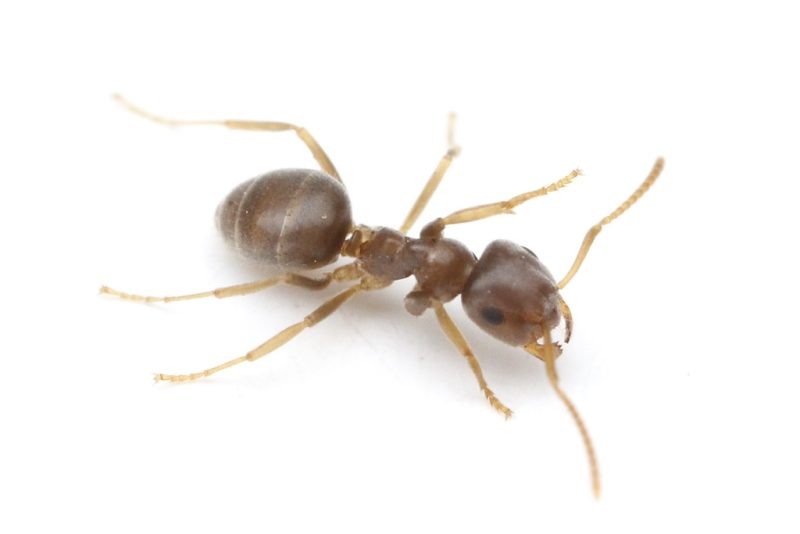
The Moisture Ant (Lasius neoniger) is a light yellow to amber-colored species commonly found throughout Montana’s grasslands and suburban lawns. Workers measure 2.5 to 4 millimeters in length and have smooth, shiny bodies with darker heads. They are ground-dwelling ants that prefer slightly damp but well-drained soils, often creating small, crater-like nests in open grassy areas and along sidewalks.
These ants are sometimes mistaken for other Lasius species, but they are distinguished by their evenly colored bodies and small mound nests with a single entrance hole. Colonies are moderate in size and typically consist of thousands of workers. Moisture Ants feed primarily on honeydew from aphids and root-feeding insects, which they tend carefully underground. They also scavenge dead insects and sugary liquids near the soil surface.
Unlike truly aggressive biting ants, Lasius neoniger is gentle and rarely bites humans. They lack a stinger and do not inject venom, making them harmless to people and pets. However, they may appear around foundations or patios, especially after rain, when the soil is moist and easier to dig. Their activity often increases in late summer, when winged reproductives swarm to form new colonies.
In Montana, Moisture Ants are common across meadows, lawns, and near woodland edges. Their underground tunnels help aerate the soil and improve water absorption, benefiting nearby plants. Though occasionally seen near moisture-damaged structures, they do not excavate wood like Carpenter Ants. They are an important part of the ecosystem, serving as soil recyclers and indicators of healthy ground conditions.
Western Harvester Ant (Pogonomyrmex occidentalis)
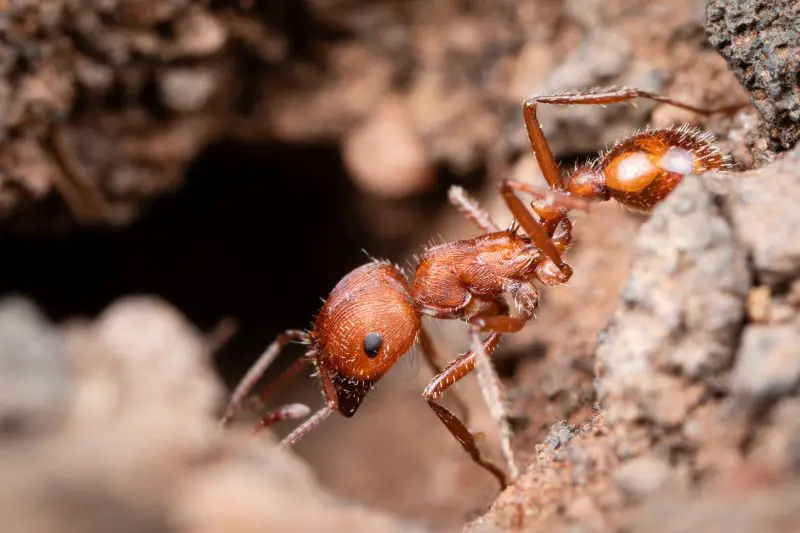
The Western Harvester Ant is one of Montana’s most distinctive and aggressive species, easily recognized by its large size and reddish coloration. Workers range from 6 to 10 millimeters long, with robust mandibles and a pair of long antennae. They build large, gravel-covered mounds in open areas such as prairies, fields, and desert-like plains. These mounds are cleared of vegetation, leaving a circular bare zone that can span several feet across.
Identification is straightforward due to their reddish bodies, smooth shiny exoskeleton, and hair-covered head adapted for seed collecting. They are named “harvester” because they gather seeds as their main food source, although they occasionally consume dead insects. Their colonies are massive and can last for decades, with individual nests housing tens of thousands of workers.
Western Harvester Ants are notorious for their painful bites and stings. Unlike many Montana ants, they possess a functional stinger and inject venom that causes intense burning pain lasting several minutes. The venom is not life-threatening but can cause swelling, redness, and itching. In rare cases, allergic individuals may experience stronger reactions. Their aggressive defense of their colony makes them a species to avoid.
In Montana, they inhabit arid grasslands and semi-desert regions in the eastern and central parts of the state. They prefer dry, sandy soils and open areas exposed to sunlight. Despite their painful stings, they are ecologically beneficial, as they help disperse seeds and aerate the soil. Observers should keep a safe distance from their mounds, especially during warm afternoons when activity peaks.
Velvety Tree Ant (Liometopum occidentale)
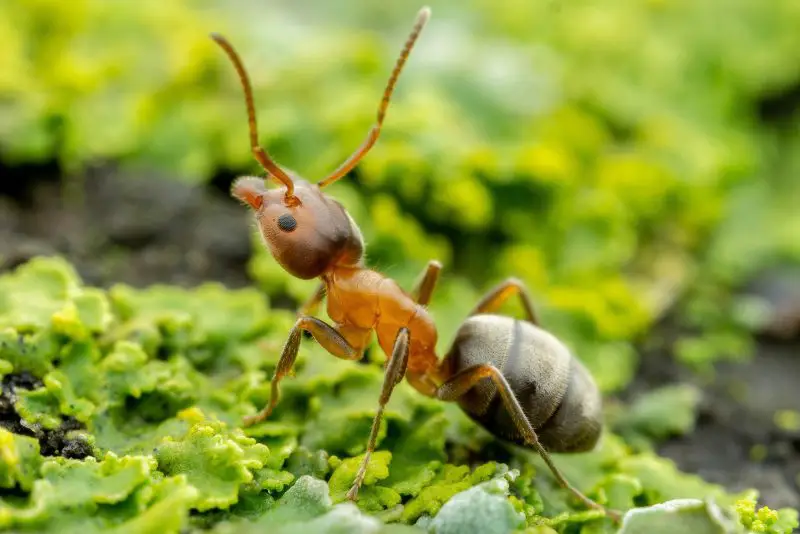
The Velvety Tree Ant is one of the more visually striking ant species in Montana, with a velvety black abdomen and reddish-brown thorax. Workers measure 4 to 6 millimeters long and move quickly in large numbers when disturbed. They typically nest in dead wood, under bark, or in the crevices of trees, especially oaks and pines. Their colonies are large and can extend over multiple trees through interconnected tunnels.
These ants are arboreal, meaning they spend most of their time above ground in trees. They are aggressive defenders of their territory and forage widely for honeydew, nectar, and insects. When alarmed, Velvety Tree Ants emit a sharp, unpleasant odor and rush out in swarms. They often invade homes located near wooded areas, entering through cracks or branches that touch roofs and walls.
Velvety Tree Ants bite readily when threatened. Their bites can be painful and are often accompanied by formic acid spray, which causes a burning sensation on the skin. While not venomous, the combination of biting and acid can result in redness and temporary discomfort. These ants do not sting but can overwhelm an intruder with their large numbers and coordinated attacks.
In Montana, Velvety Tree Ants are typically found in forested foothills and mountainous regions, particularly near rivers or old-growth trees. They play an important ecological role by helping to decompose decaying wood and controlling insect populations. Homeowners near wooded areas should trim trees that touch structures to reduce the risk of infestations.
Thief Ant (Solenopsis molesta)
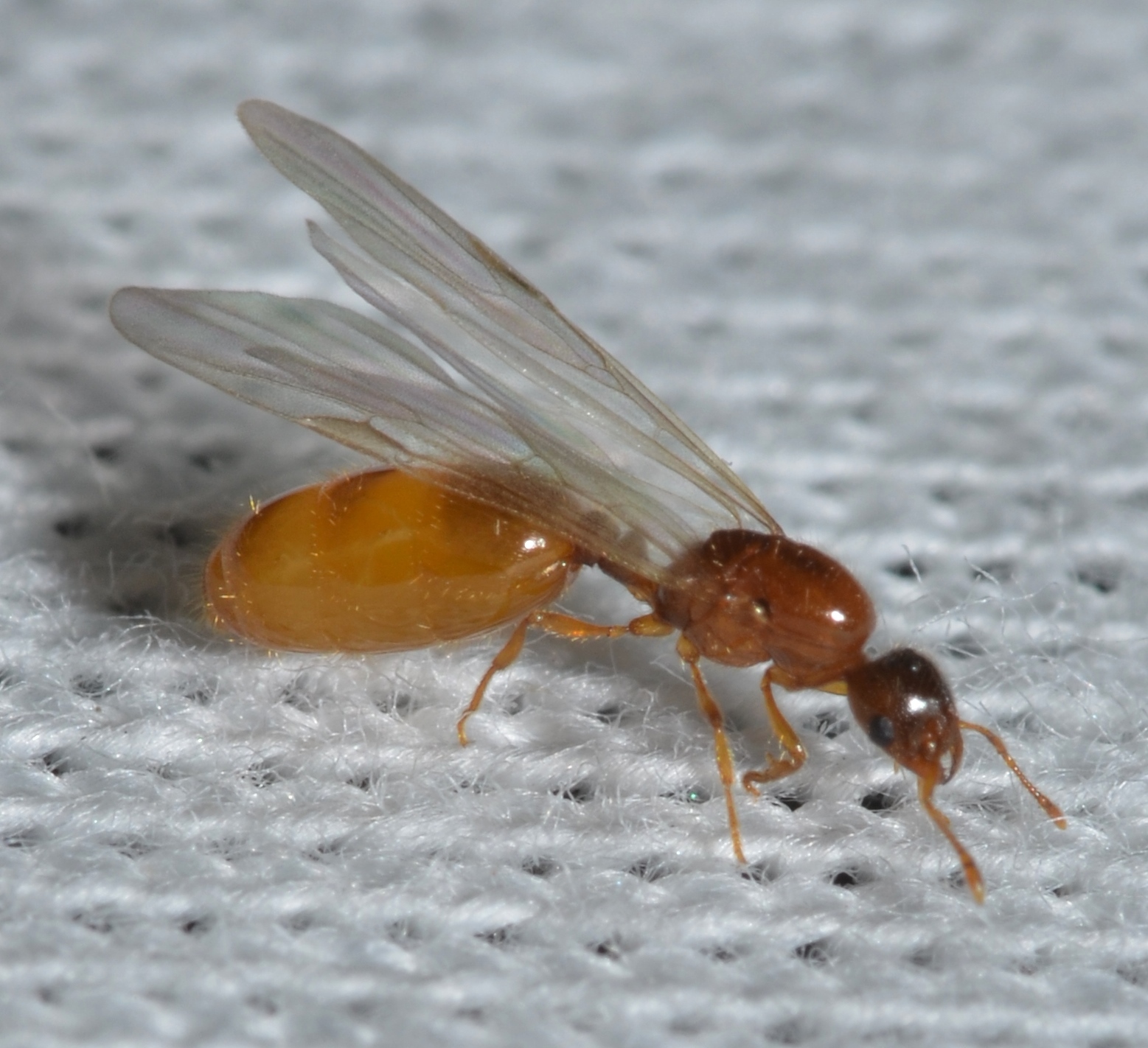
The Thief Ant, also known as the Grease Ant, is one of Montana’s tiniest ant species, with workers measuring just 1.5 to 2 millimeters long. Their pale yellow to light brown coloration and small size make them difficult to spot with the naked eye. True to their name, they often establish colonies near other ant nests, stealing food, larvae, and pupae from their neighbors. This parasitic behavior gives them a unique niche in Montana’s ant ecosystem.
Identification of Thief Ants is challenging due to their size and resemblance to other small species. They are typically found nesting indoors in wall voids, under floors, or near heat sources. Outdoors, they inhabit soil, under rocks, and within decaying wood. Thief Ants feed on a wide variety of foods, including grease, meat, sweets, and other insects, making them common kitchen invaders.
These ants can bite, but their bite is so weak that it is rarely felt. They do not sting or inject venom, posing no medical risk. However, they are considered a nuisance pest because they contaminate food sources and can invade stored goods. Due to their small size, they easily bypass many household barriers and can be difficult to eliminate without professional pest control.
In Montana, Thief Ants are found throughout urban and suburban areas, especially during late summer when colonies are most active. They thrive in warm, dry environments and often coexist with other ant species. Though they are small, their persistent presence and secretive habits make them one of the more troublesome ants to control in homes.
Tips for Preventing Ant Bites and Infestations in Montana
Ant infestations across Montana can range from mild nuisances to painful encounters with biting or stinging species. Preventing these ants from invading your home and property requires consistency and attention to both hygiene and environmental conditions. Many species, including Thatching Ants, Field Ants, and Harvester Ants, become more active in the warm months, so early prevention is key.
Begin by sealing off possible entry points. Inspect your home’s foundation, doors, and windows for cracks or gaps, and use weatherproof sealant to close them. Ants are small and can easily enter through plumbing lines or utility openings, particularly species like Moisture Ants and Odorous House Ants that are drawn to damp areas. Keeping your home clean, free of crumbs, and dry will deter most infestations.
Outside the home, reduce potential nesting sites by clearing vegetation and debris. Trim back branches that touch walls or roofs, since tree-dwelling ants such as Velvety Tree Ants can use these as bridges to enter buildings. Avoid leaving pet food outdoors, and clean up sweet residues that attract foraging workers. Stay cautious around visible mounds, as species like Thatching Ants and Harvester Ants will defend their colonies aggressively.
When infestations develop, natural remedies like diatomaceous earth or boric acid bait traps can help manage small colonies effectively. For larger or repeated invasions, professional pest control may be required. Because Montana’s ants retreat underground during winter, early spring is the ideal time to apply long-term control measures and inspections. Consistent maintenance ensures both comfort and protection from painful bites or stings.
FAQs About Biting Ants in Montana
Are there dangerous ants in Montana?
Most Montana ants are not dangerous, but several species can bite or sting with noticeable pain. The Western Harvester Ant delivers a venomous sting that causes intense burning, while Field Ants and Thatching Ants bite and spray formic acid that irritates skin. Although these bites are rarely serious, individuals with allergies or sensitive skin should exercise caution around ant mounds.
Which ants are most likely to invade homes in Montana?
Odorous House Ants, Pavement Ants, Little Black Ants, and Thief Ants are the most common indoor invaders. They seek moisture, warmth, and food, nesting behind walls or under floors. Once inside, these ants can be persistent, particularly during spring and summer. Keeping surfaces clean, repairing leaks, and sealing gaps are simple but effective methods to deter them.
How can I identify ant species that bite or sting?
Biting and stinging ants tend to be larger, more aggressive, and heavily territorial. Thatching Ants build large thatched mounds and swarm quickly when disturbed. Harvester Ants have reddish bodies, powerful jaws, and smooth gravel-covered nests. Observing their mound size, activity level, and body color can help you distinguish them from harmless household ants.
What should I do if I’m bitten or stung by an ant?
Clean the area immediately with soap and water to remove venom or formic acid. Applying ice packs or an antihistamine cream can reduce swelling and irritation. Avoid scratching the bite site to prevent infection. Most symptoms fade within a few hours, but in rare cases of severe allergic reaction or persistent swelling, seek medical attention promptly.
Why do ants build large mounds in Montana’s grasslands?
Large mounds built by species like the Allegheny Mound Ant or Thatching Ant act as temperature-regulating structures. The elevated design allows sunlight to warm the nest, keeping it suitable for brood development. These mounds also protect the colony from predators and flooding. They can last for years and often mark long-established colonies in sunny open fields.
Can ants damage wooden structures?
Carpenter Ants are the main structural pest species in Montana. They do not consume wood but excavate it to form smooth tunnels for nesting. Over time, this weakens beams, walls, and decks, especially in areas with moisture damage. Addressing leaks, replacing rotted wood, and using ant baits can prevent serious infestations and long-term damage.
When are ants most active in Montana?
Ants in Montana are most active from late spring through early fall, when temperatures favor foraging and reproduction. During the winter months, most species retreat underground or into insulated wood to survive freezing conditions. Swarming typically occurs in midsummer, when winged reproductives leave the nest to start new colonies.
Are any ant species beneficial to Montana’s environment?
Yes, many native ants are crucial to the ecosystem. Field Ants and Harvester Ants aerate the soil and disperse seeds, while Thatching Ants recycle organic matter. Even species that bite play valuable roles in pest control and soil health. Complete eradication is not necessary; balanced management allows beneficial ants to thrive without becoming pests.
What natural methods can control ant infestations?
Natural deterrents include vinegar sprays, lemon juice, or cinnamon around entry points to disrupt scent trails. Food-grade diatomaceous earth can be sprinkled around foundations to dehydrate and kill ants safely. Consistent cleanliness, removing standing water, and storing food in airtight containers are the most reliable preventive measures.
Should I call pest control for ants in Montana?
Professional pest control is recommended for large, persistent, or wood-infesting species. Carpenter Ants and Harvester Ants often require specialized treatment to eliminate entire colonies. Experts can identify the species accurately and apply targeted, eco-safe methods that reduce recurrence. For small indoor infestations, household traps and diligent cleaning may be sufficient.



